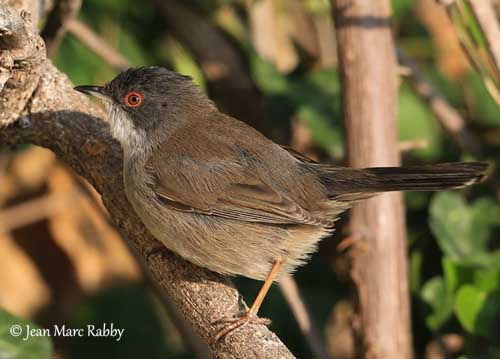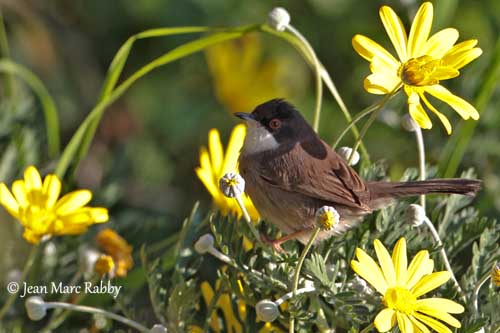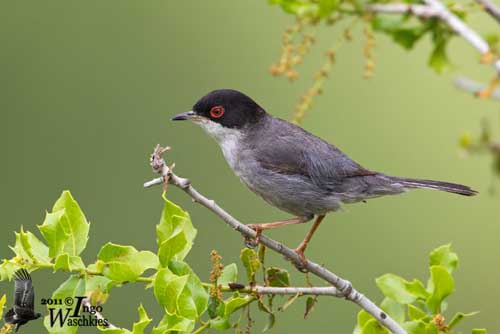
Fr: Fauvette mélanocéphale
All: Samtkopf-Grasmücke
Esp: Curruca de Cabeza Negra
Ital: Occhiocotto
Nd: Kleine Zwartkop
Sd: Sammetshätta
Photographers:
José Luís Beamonte
Pájaros de España
Jean Marc Rabby
Des Ailes et des Plumes
Ingo Waschkies
Bird Photography
Nicole Bouglouan
PHOTOGRAPHIC RAMBLE
Texte de Nicole Bouglouan
Sources:
HANDBOOK OF THE BIRDS OF THE WORLD Vol 11 by Josep del Hoyo, Andrew Elliott and David Christie - Lynx Edicions - ISBN: 849655306X
THE HANDBOOK OF BIRD IDENTIFICATION FOR EUROPE AND THE WESTERN PALEARCTIC by Mark Beaman, Steve Madge - C.Helm - ISBN: 0713639601
ENCYCLOPEDIE DES OISEAUX DE FRANCE ET D’EUROPE – de Peter Hayman et Rob Hume - Flammarion – ISBN : 2082009920
BIRDS OF THE MIDDLE EAST by R.F. Porter, S. Christensen, P Schiermacker-Ansen C.Helm - ISBN: 0713670169
BirdLife International (BirdLife International)
Wikipedia, the free encyclopaedia
Sardinian Warbler
Sylvia melanocephala
Passeriforme Order – Sylviidae Family
BIOMETRICS:
Length: 13 cm
Weight: 12-25 g
DESCRIPTION:
The Sardinian Warbler appears like the most widespread of the southern species of genus Sylvia. Very secretive, this pretty warbler frequents the maquis scrub. This is a bulky and robust warbler.
The adult male has dark ash-grey upperparts and wing-coverts, whereas mantle and scapulars are tinged brown. The flight feathers are blackish with grey edges. The tail is blackish with whitish edges and white tip.
The underparts are greyish-white. Chin and throat are white.

The head is glossy black. The bill is blackish with paler base of lower mandible. The eyes are red-brown, surrounded by reddish eye-ring. Legs and feet are brownish.
In non-breeding plumage, the male has more olive upperparts and less blackish head.
The adult female in breeding plumage is duller than male with dull grey head, brownish upperparts and cream-buff underparts with brownish-olive body sides. Bare parts are often paler than in male.
In non-breeding plumage, she has tinged brownish head and duller contrasts.
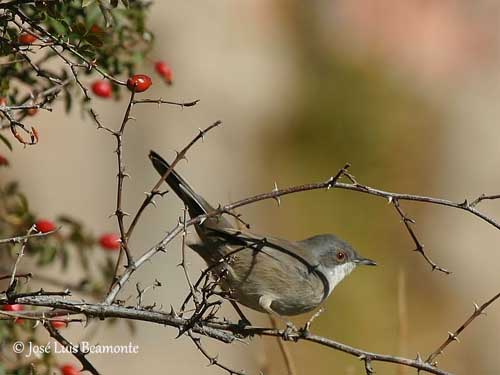
The juvenile resembles female but it is duller and browner. Its eyes are greyish with pale reddish eye-ring.
We can find four subspecies:
S.m. melanocephala, here described, is found in S Europe (Mediterranean Basin and islands), E to Bulgaria and S Romania, W Turkey and NW Africa.
S.m. leucogastra from Canary Islands is smaller, with more rounded wings. It has less white on outer rectrices. The race is paler on E Islands, but darker on those of Palma and Tenerife.
S.m. valverdei from S Morocco and W Sahara has paler upperparts and lacks the greyish and brownish tones. The male has matt cap, not glossy.
S.m. momus from Lebanon, S to extreme NE Egypt, is smaller and paler overall.
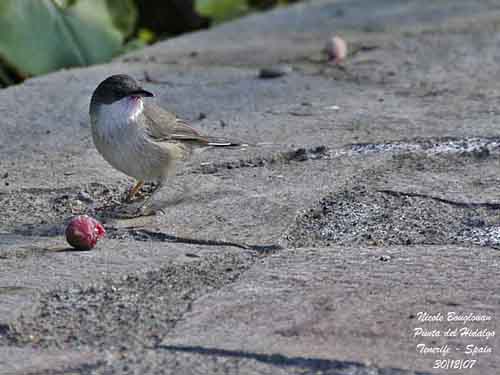
VOICE: SOUNDS BY XENO-CANTO
The Sardinian Warbler’s typical call is a sudden, loud “t-ra, t-ra, t-ra, t-ra” often accompanied by rattled chattering “tr-tr-tr”. The alarm call is a more nasal “djj-djj-djj-djj-djj…”. We can also hear a short, harsh “tchur” and “cherk-cherk”.
The musical song is a rapid chatter of 2-3 seconds, including “t-r” notes with short whistles. The song is given from top of bush or during the flight displays.
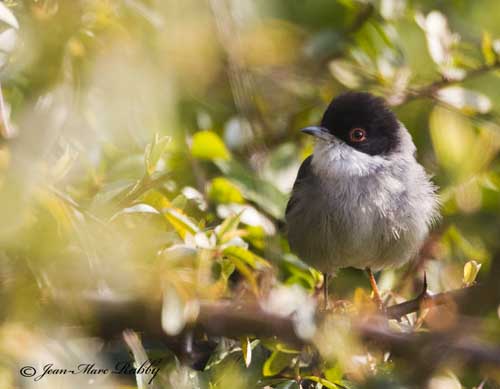
HABITAT:
The Sardinian Warbler frequents various types of warm habitats, from low elevation and up to 1200-1300 metres, and even up to 1800 metres in NW Africa.
This species usually occurs in dry coastal habitats, garrigue, maquis, gardens, but also in cultivated areas such as olives, almonds, orchards, citrus groves and vineyards in Mediterranean regions. It also needs some vegetation with bushes, hedgerows, pine thickets, and low dense forest with bushy undergrowth.
During winter and on passage, the Sardinian Warbler favours all scrubby habitats, semi-desert and desert oases.
RANGE:
See above in “subspecies”
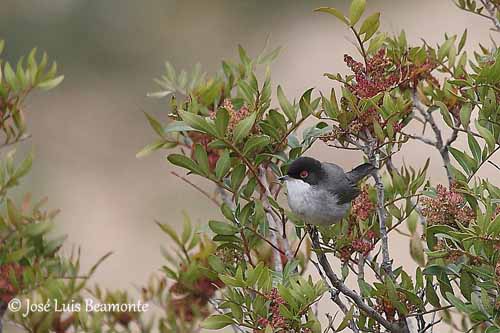
BEHAVIOUR:
The Sardinian Warbler feeds mainly on arthropods, but it also takes fruits and berries in autumn and winter, and throughout the year according to the food availabilities. This bird may consume nectar too, especially in late winter and early spring, and probably regularly.
Some birds sometimes defend part of their feeding areas against smaller species. They usually forage in scrub, on the ground and in low trees.
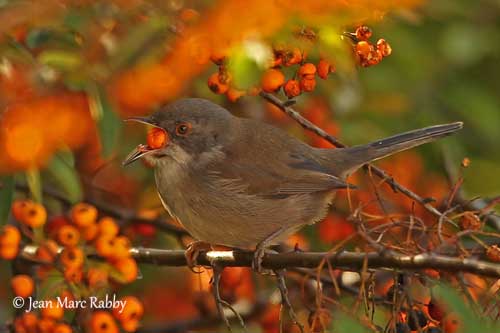
During the breeding season, the resident male performs flight displays accompanied by song in February. The bird rises 2-3 metres into the air and glides with raised wings. Then, it returns to the same perch or another one.
The territory is defended all year round, and the male gives advertising calls from perches. But the short typical song-flight enhances the result of this territorial song, by adding the sight of the moving bird.
The flying bird performs slow wingbeats, making it more conspicuous. This type of flight occurs in relatively open areas.
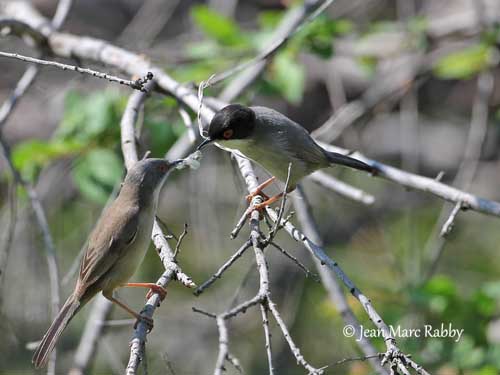
The Sardinian Warbler is partially migratory. The birds of coastal regions and coasts are more sedentary than inland and northern populations. There is a post-breeding migration from late August to December. Most movements are short, but long-distance migrations probably occur too.
The juveniles disperse during autumn, but local movements are also observed in all populations, according to the food availabilities, mainly berries.
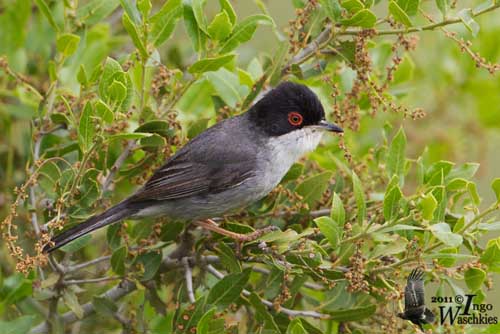
FLIGHT:
The Sardinian Warbler has a jerky flight action when flying over low scrub, but when it dives back into cover, the tail is spread, showing the white corners.
REPRODUCTION:
The Sardinian Warbler breeds between March and June. This species produces 1-3 broods, but usually 2 per season. They are monogamous.
The female builds the nest, a cup of grass, usually placed about 30-60 cm above the ground. The nest is hidden in scrub or bush, occasionally among tussocks or in small tree.
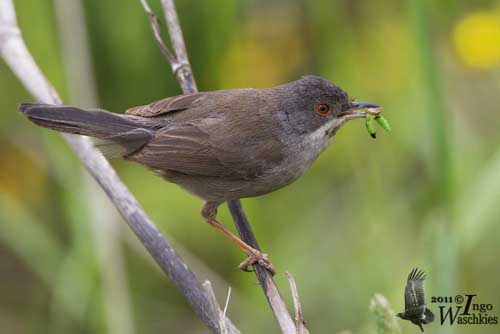
The female lays 3-5 eggs, and both sexes incubate during 12-15 days. The chicks are fed by both adults, and fledge 12-13 days after hatching. They still depend on parents for 2-3 weeks.
DIET:
The Sardinian Warbler feeds primarily on arthropods, but it also consumes a large amount of fruit and berries in autumn and winter, and nectar too.
Invertebrates include insects and larvae of numerous species, spiders and small snails. They may visit bird-feeders in winter.
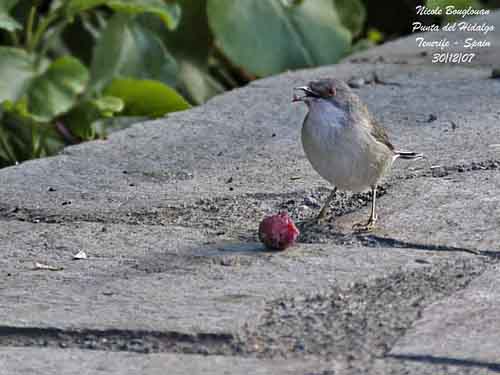
PROTECTION / THREATS / STATUS:
The Sardinian Warbler can be very common in suitable habitat. This species has expanded its range in Spain, France, Italy, Bulgaria, Romania, Malta and Cyprus, since 19th century. The species can be affected by harsh winters.
But currently, the Sardinian Warbler is not threatened.
